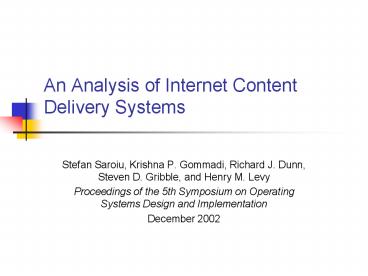An Analysis of Internet Content Delivery Systems - PowerPoint PPT Presentation
Title:
An Analysis of Internet Content Delivery Systems
Description:
For both Web and Kazaa, small number of clients account for large portion of traffic ... Would expect server load for Kazaa to be much more distributed than for WWW ... – PowerPoint PPT presentation
Number of Views:86
Avg rating:3.0/5.0
Title: An Analysis of Internet Content Delivery Systems
1
An Analysis of Internet Content Delivery Systems
- Stefan Saroiu, Krishna P. Gommadi, Richard J.
Dunn, Steven D. Gribble, and Henry M. Levy - Proceedings of the 5th Symposium on Operating
Systems Design and Implementation - December 2002
2
Outline
- Goals of Paper
- Overview of Content Delivery Systems
- Experimental Methodology
- Results
- Caching
- Conclusions
3
Goals
- Quantify the increasing importance of novel
content delivery systems - Characterize the behavior of these systems from
the perspectives of clients, objects, and servers - Derive implications for caching in these systems
4
Content Delivery Systems
- HTTP Web Traffic
- Content Delivery Networks
- Akamai
- Peer-to-peer file sharing networks
- Gnutella
- Kazaa
5
HTTP Traffic
- Clients request objects from web servers using
HTTP - Most web objects are small, 5-10KB.
- Web object requests follow a Zipf-like
distribution - Caching
- Cache hit rate increases logarithmically with
client population - Impossible for dynamic content
6
Zipf Distribution Compared with Sun Log Data
7
Content Delivery Networks (CDNs)
- Dedicated collections of servers that are
geographically distributed - Provide static content, e.g. images, streaming
video - Allows user to access replica of content that is
close - Replica location done via DNS interposition or
URL rewriting at origin servers - Redirection adds overhead
- Reduces average download response time
8
Peer-to-Peer Systems
- Peers form a distributed system to exchange
content - Batch-style downloads
- Most peers have low-availability and limited
network capacity - Files transferred via direct connection between
peers
9
Experiment Methodology
- Use passive network monitoring to collect trace
of TCP traffic between University of Washington
(UW) to rest of Internet - Collected 9 days of data, over 20 TB
10
Some Interesting Observations
- UW is an HTTP content provider
- Exported 16.65 TB. Imported 3.44 TB
- Bandwidth consumption (inout)
- .2 Akamai
- 6.04 Gnutella
- 14.3 WWW
- 36.9 Kazaa
- Rest is other TCP protocols mail, streaming
video/audio, etc.
11
Some More Interesting Observations
- Compared to 1999 study
- HTML traffic has decreased 43
- GIF/JPG traffic has decreased 59
- AVI/MPG traffic increased nearly 400
- MP3 traffic increased nearly 300
12
Objects
- Median P2P object size is 4MB.
- Median Web object is 2KB
- 5 of Kazaa objects are over 100MB
- Top 1 of Kazaa objects account for 50 of bytes
transferred - For Web, top 1 account for 16 of bytes
transferred
13
Clients
- For both Web and Kazaa, small number of clients
account for large portion of traffic - In Web, top 200 clients (0.5 of the population)
account for 13 of the traffic - In Kazaa, top 200 clients (4 of the population)
account for 50 of the traffic
14
Servers
- Would expect server load for Kazaa to be much
more distributed than for WWW - This is not the case
- Top 500 external Web servers provide 22 of the
bytes - Top 500 external Kazaa servers provide 10 of the
bytes
15
Scalability
- With respect to bandwidth cost adding another
450 Kazaa clients would be equivalent to doubling
the web client population (from 40,000 to 80,000)
16
CDN Caching
- Do CDNs provide any performance benefits over
local proxy cache? - If Akamai traffic were directed to proxy cache
instead - 88 ideal object hit rate (all objects cacheable)
- 50 practical hit rate
- Conclusion Widely deployed proxy caches reduce
need for separate CDNs
17
P2P Caching
- Inbound cache byte hit rate 35
- Outbound cache byte hit rate 85
- Hit rate increases with client population
- 1,000 clients 40 hit rate
- 500,000 clients 85 hit rate
- Conclusion Reverse P2P cache saves the most
bandwidth
18
Conclusions
- P2P traffic accounts for majority of HTTP bytes
transferred - P2P objects are significantly larger than Web
objects - Small number of large objects account for a large
percentage of P2P traffic - Small number of clients and servers responsible
for majority of P2P traffic - P2P traffic creates significant bandwidth load































